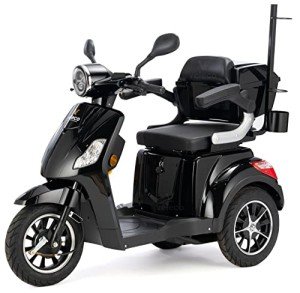A Comprehensive Guide to Buying a Mobility Scooter
Mobility scooters have actually become a crucial tool for numerous people aiming to boost their self-reliance and mobility. With a huge variety of designs and functions available, choosing the ideal mobility scooter can be daunting. This short article offers a useful guide to assist customers navigate their choices, evaluate their needs, and make a notified purchase.
Understanding Mobility Scooters
Mobility scooters are electric vehicles designed for individuals who experience mobility difficulties. They are particularly beneficial for seniors, those with impairments, or people recovering from injuries. Mobility scooters can vary widely in regards to design, functions, and pricing.
Types of Mobility Scooters
Before starting a purchase, it's necessary to understand the different kinds of mobility scooters offered:
Three-Wheel Scooters:
- Generally more maneuverable in tight areas
- Lightweight and portable
- Ideal for indoor usage
Four-Wheel Scooters:
- Offer greater stability and balance
- Appropriate for outside use over numerous terrains
- Typically have a longer battery life
Foldable/Portable Scooters:
- Designed to be easily transported and stored
- Can often fit in the trunk of a vehicle
- Perfect for those who travel often
Heavy-Duty Scooters:
- Built to accommodate bigger individuals
- Typically included more robust features for outdoor usage
- Typically geared up with larger batteries for prolonged variety
Aspects to Consider When Buying a Mobility Scooter
1. Weight Capacity
Select a mobility scooter that can support the user's weight. Most scooters have a weight limit varying from 250 to 500 pounds. It is important to ensure that the scooter can accommodate the user comfortably.
2. Variety and Battery Life
The range is how far the mobility scooter can travel on a single charge. Normal varieties differ between 10 to 30 miles. Consider the user's everyday activities and select a scooter with a suitable variety.
3. Scooter Dimensions
Think about the size of the scooter, including its weight and measurements. A more compact scooter might be perfect for narrow hallways and tight spaces, while larger models use additional stability and comfort.
4. Terrain Capability
Examine where the scooter will mostly be used. If the user prepares to travel mostly on pavement, a lightweight model may be adequate. However, if the user needs to traverse gravel or unequal surface areas, consider a four-wheel scooter developed for off-road usage.
Top Features to Look For
Comfort
- Adjustable Seats: Look for scooters with cushioned and height-adjustable seats to ensure comfort during travel.
- Armrests: These enhance security and support while navigating.
Security and Visibility
- Headlights and Taillights: Essential for nighttime use.
- Turn Signals and Reflectors: Improve exposure and safety while on the roadway.
User-Friendly Controls
- Joystick or Drive Controls: These must be user-friendly and simple to manipulate.
- Easy-to-Read Displays: A control panel that shows battery life, speed, and range can enhance the user experience.
Additional Features
- Storage Compartments: These provide included benefit for bring individual items while on the go.
- Weather condition Protection: Consider models with rain covers or windshields if utilized in variable climate condition.
Cost Considerations
When budgeting for a mobility scooter, prices can vary anywhere from ₤ 500 to over ₤ 5,000 depending upon the design, functions, and brand name. Additional expenses may include:
- Extended Warranty: Protects versus flaws and can save money in the long run.
- Accessories: Optional functions, such as upgraded seats, lights, or storage options.
| Function | Cost Range |
|---|---|
| Standard Models | ₤ 500 - ₤ 1,500 |
| Mid-Range Models | ₤ 1,500 - ₤ 3,000 |
| High-End Models | ₤ 3,000 - ₤ 5,000 |
Financing Options
Numerous merchants provide funding strategies, and some local government initiatives may offer grants or assistance for those in need. Examine prospective financial assistance with neighborhood resources or mobility service organizations.
Frequently asked questions about Buying a Mobility Scooter
What is the distinction in between a mobility scooter and a wheelchair?
Mobility scooters are motorized and permit users to browse individually, while wheelchairs might need physical help or manual operation.
How do I keep a mobility scooter?
Routine maintenance includes examining battery life, cleaning up the scooter, and checking tires and brakes. Always describe My Mobility Scooters for specific standards.
Can mobility scooters be used inside?
Yes, lots of models are designed for both indoor and outdoor use. Nevertheless, three-wheel scooters tend to be much better suited for indoor navigation due to their tighter turning radius.
Are mobility scooters covered by insurance?
Some insurance prepares cover a part of the costs for mobility scooters if they are considered clinically required. Contact your service provider for particular details.
How quick can a mobility scooter go?
A lot of mobility scooters have an optimal speed ranging from 4 to 8 mph. Nevertheless, the suitable speed might vary depending upon regional regulations.
Getting a mobility scooter can considerably improve one's self-reliance and quality of life. By comprehending the types, features, and costs related to mobility scooters, potential buyers can make well-informed decisions that match their requirements and preferences. Customization and comprehensive research are essential to guaranteeing complete satisfaction with this crucial financial investment.

